Philips PML 9009 is the top LCD television from the manufacturer, featuring Mini LED backlighting. The device itself boasts excellent build quality, a stylish remote, and the manufacturer's exclusive multicolour Ambilight backlighting. In terms of picture quality, one could note a slight downside regarding black levels and contrast, which, to be honest, are not among the best and do not deliver as deep and vivid an image as seen in televisions from similar price ranges. However, it is worth mentioning that thanks to good algorithms responsible for the picture, its tonal quality was quite satisfactory. Therefore, the relatively low brightness of the display is well masked here and, with the implementation of Dolby Vision technology, allows access to the world of HDR content. What definitely deserves attention is the fluidity of transitions, which were truly outstanding and better than in some significantly more expensive units. The greatest advantage of this television is its performance in gaming. One cannot say a bad word about this aspect as the television truly shines here and will surely satisfy every user. The motion smoothing system is also one of those things for which the television deserves praise. With two sliders, the effect of which is noticeable at each position, every user can find the best degree of smoothness for themselves. Therefore, it can be confidently stated that when choosing a television for sports, one can point to PML9009 Philips as an excellent candidate. Although the TitanOS operating system is currently in the development phase and lacks a significant number of applications, we do not believe that the manufacturer will do nothing in this regard.
- Matching (Score)
- Our verdict
- TV appearance
- Where to buy
- Contrast and black detail
- HDR effect quality
- Factory color reproduction
- Color reproduction after calibration
- Smoothness of tonal transitions
- Image scaling and smoothness of tonal transitions
- Blur and motion smoothness
- Console compatibility and gaming features
- Input lag
- Compatibility with PC
- Viewing angles
- TV efficiency during daytime
- Details about the matrix
- TV features
- Apps
- Playing files from USB
- Sound
Philips PML9009 / 9019 / 9059 vs TCL C6K
Direct compare
The Xtra / PML9019 / PML9059 / PML9009 / PML9049 / AMBILIGHT TV
C6K / C69K / Q6C


Panel type: LCD VA
Resolution: 3840x2160
System: Titan OS
Model year: 2024
Complete the survey to find out the result

Panel type: LCD VA
Resolution: 3840x2160
System: Google TV
Model year: 2025
Complete the survey to find out the result

Overall rating
6.8
7.1
Movies and series in UHD quality
6.5
6.7
Classic TV, YouTube
6.3
6.6
Sports broadcasts (TV and apps)
6.6
6.3
Gaming on console
8.5
8.4
TV as a computer monitor
8.6
8.6
Watching in bright light
6.1
6.4
Utility functions
6.0
7.0
Apps
6.2
9.6
Sound quality
6.7
6.5
Complete the survey to find out what fits your preferences
Advantages
Very good tonal quality of scenes exceeding the capabilities of the television
Well-functioning dynamic tone mapping feature
Colour reproduction after calibration
Functionality after connecting to console/PC
Very good contrast and black levels: VA panel and MINI-LED backlighting
Good motion smoothness: High refresh rate of 144Hz
Decent panel brightness
Many features for gamers: VRR, ALLM, HDMI 2.1, HGiG
Additional mode for PC gamers: 240Hz
GoogleTV system with a wide selection of apps
Support for multiple HDR formats including Dolby Vision
Support for Dolby Atmos and DTS
Very attractive price
Disadvantages
Significant halo/bloom effect
Poor viewing angles
The TitanOs system is not as developed as the competition
Average contrast and black levels
Management of the backlighting could be better
Language errors in the system
Our verdict
TCL C6K is a TV for those who want to combine gaming and watching movies with good contrast, all without breaking the bank. With its VA panel illuminated by Mini-LED, blacks are deep and contrast is high, making evening viewings look truly impressive. Additionally, it boasts decent brightness, which paired with Dolby Vision gives films a cinematic quality. Importantly, the smoothness of the image – the 144Hz refresh rate works wonders for sports and dynamic games, and gamers receive a full package of bonuses: VRR, ALLM, HDMI 2.1, HGiG, and even a 240Hz mode in PC. For daily use, the TV is powered by Google TV, which offers a multitude of apps and the Gemini AI voice assistant, making navigation convenient and flexible. It's also worth mentioning the sound – support for Dolby Atmos and DTS gives the impression that the device is ready not just for gaming. As is often the case, there are a few things that could be improved. The backlighting in challenging scenes can lose details or wash out blacks, and the Polish translations in the menu can be so clumsy that you really have to think about what’s being said. Despite this, the overall package holds up very well, and considering the price, the TCL C6K could be one of the more interesting choices for anyone looking for a versatile TV for movies, sports, and gaming. Especially when a good promotion comes along – and when TCL traditionally fine-tunes the details in updates.
TV appearance




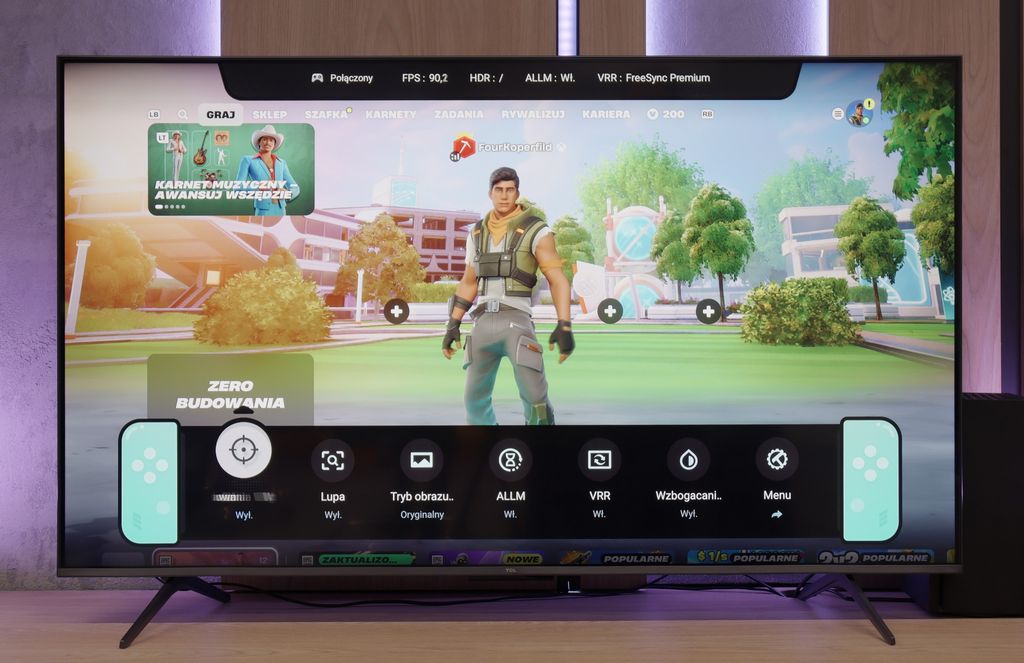
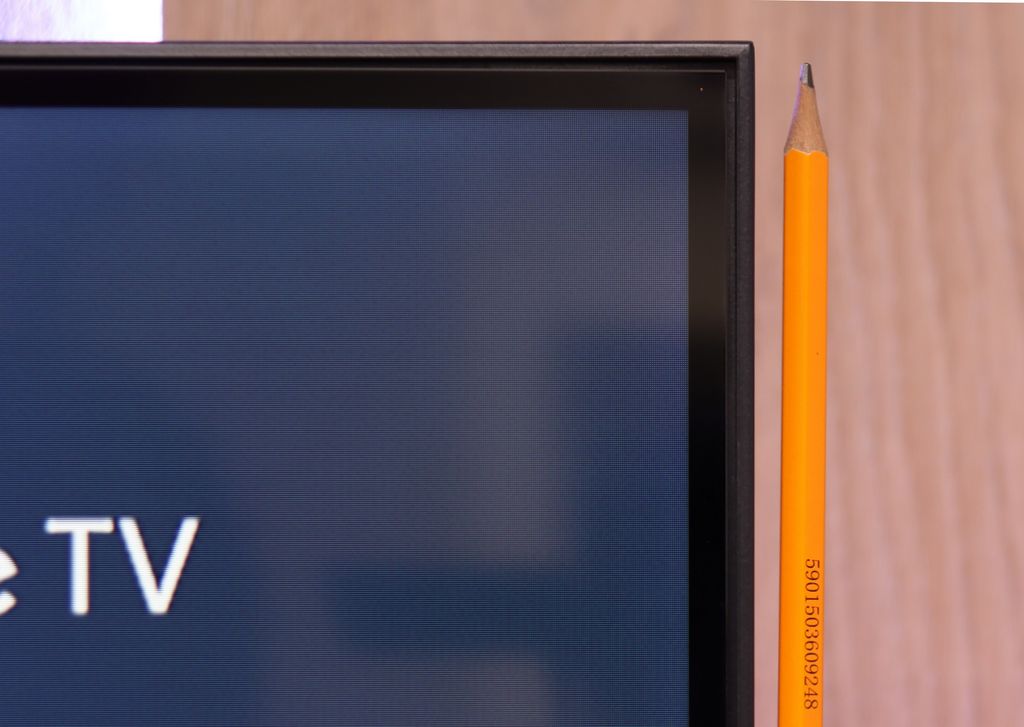
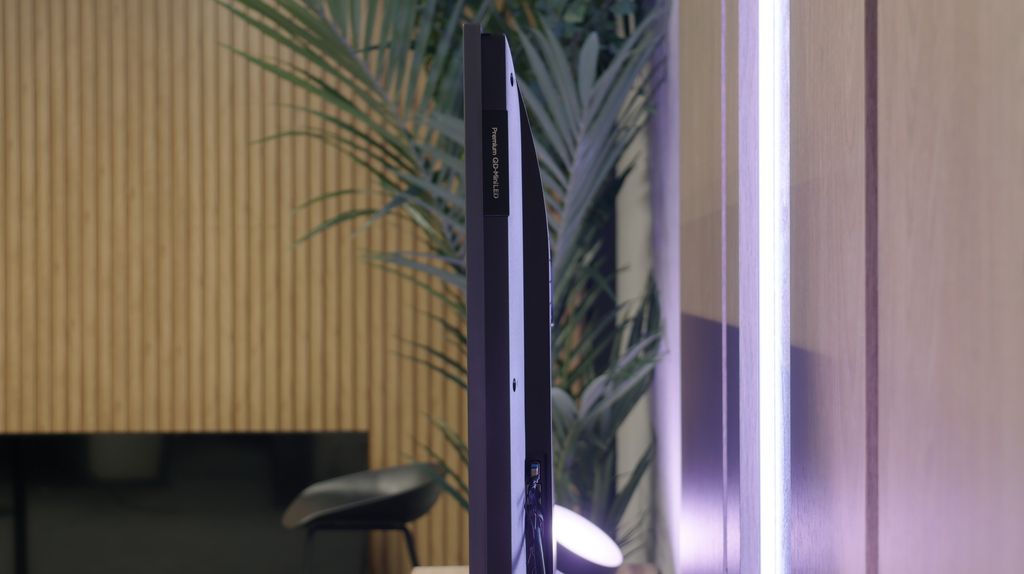
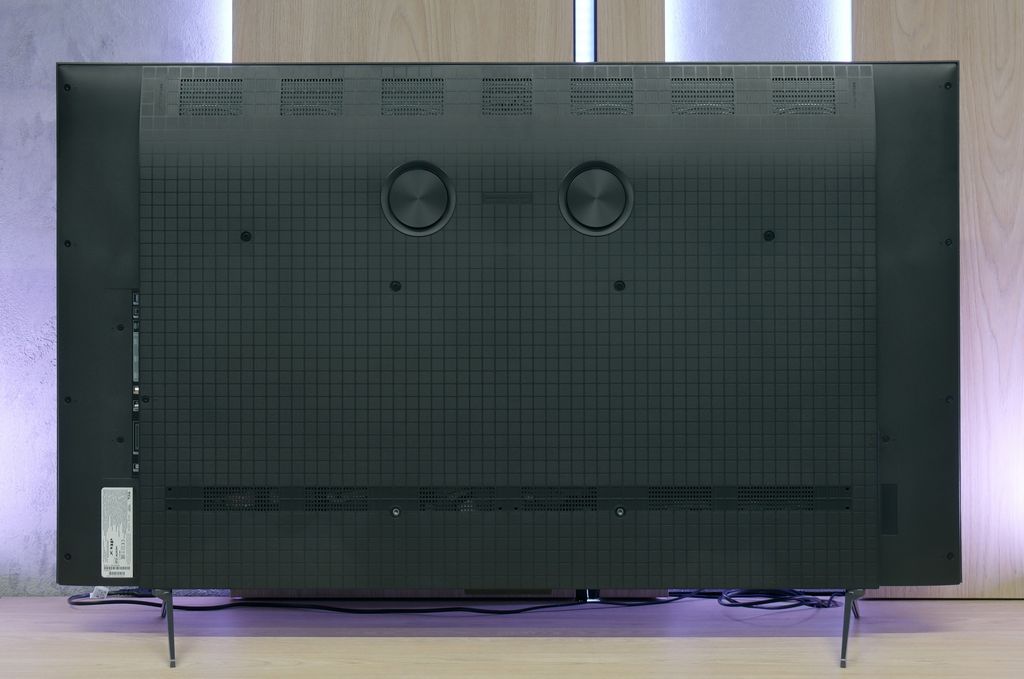
Contrast and black detail
6.6/10
7.3/10
Local dimming function: Yes, number of zones: 75 (15 x 5)
Local dimming function: Yes, number of zones: 180 (10 x 18)
Contrast:

Result
132,000:1

Result
16,550:1

Result
14,450:1

Result
7,850:1

Result
6,650:1

Result
114,000:1

Result
17,300:1

Result
16,200:1

Result
9,900:1

Result
4,850:1
Halo effect and black detail visibility:

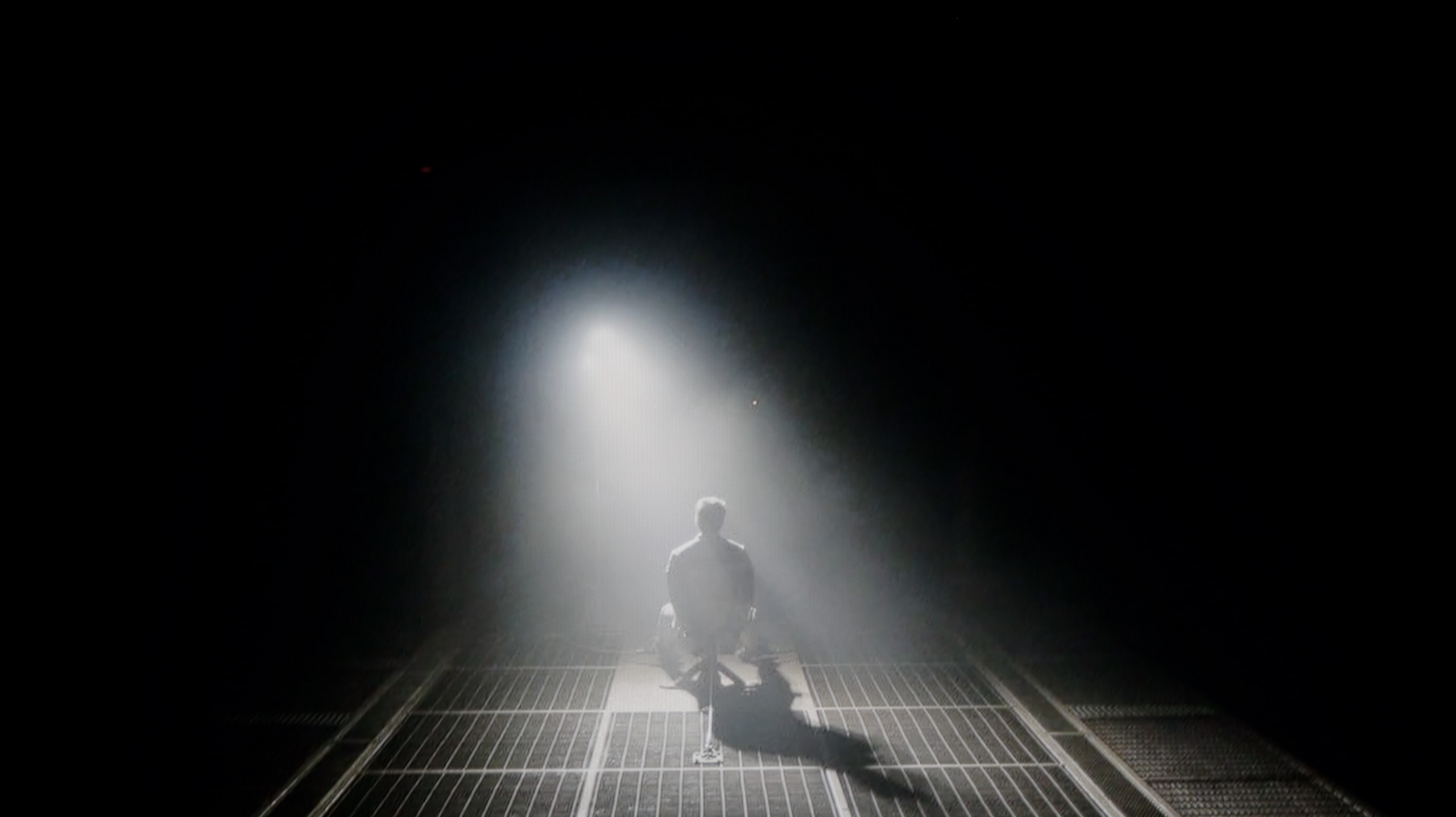
Philips PML9009 is equipped with a high-contrast VA panel. While it doesn’t deliver as deep and vivid an image as OLED televisions, it is still a much better solution for home cinema compared to IPS/ADS panels. The measured static contrast (without local dimming activated) of 6000:1 is considered very good and allows the Mini LED backlighting implemented in the tested television to shine. The results of the contrast and black measurement, as you can see for yourself, are not among the highest, and the only scene where the television exhibited satisfactory results was from the movie "Oblivion," where the unit deserves praise for its light separation, which is not such an obvious thing even in much more expensive models. We should also add that all tests were conducted at medium dimming power, as the lowest option provided unsatisfactory black levels, while the highest one lost significant detail. Unfortunately, our standard testing procedure with the film "Sicario 2" did not go as well as hoped. Yes, all the details in the second and third planes are very visible, but due to the operation of local dimming, the overall tonal balance was severely disrupted, not to mention the strong halo effect around the bright elements of the helicopter.
The TCL C6K is based on a VA panel, specifically an HVA produced by TCL CSOT, which already delivers a solid native contrast of 6000–7000:1 without the use of local dimming. However, the true strength of this model lies in its Mini-LED backlighting with the ability to dim individual zones. In the tested 55-inch version, we counted around 180 zones, and as the diagonal size increases, this number naturally grows. For a television in this price segment, the contrast is truly impressive. In simpler film scenes, such as segments from 'Oblivion', it looks fantastic, and shots completely filled with black make a great impression. Of course, due to the characteristics of Mini-LED technology, it's not always possible to avoid issues – in more challenging frames with many bright details, halo effects can appear, or some elements may be dimmed too strongly (regardless of local dimming settings). Nevertheless, the contrast can be regarded as a strong point of the C6K.
HDR effect quality
6.1/10
4.9/10
Luminance measurements in HDR:

Result
548 nit

Result
550 nit

Result
824 nit

Result
491 nit

Result
582 nit

Result
612 nit

Result
202 nit

Result
424 nit

Result
144 nit

Result
587 nit
Scene from the movie “Pan” (about 2800 nits)


Scene from the movie “Billy Lynn” (about 1100 nits)


Static HDR10


Dynamic: Dolby Vision
Dynamic: Dolby Vision


HDR luminance chart:
TCL C6K
Luminancja HDR
Luminance of RGB colors
Philips PML9009 / 9019 / 9059
Luminancja HDR
Luminance of RGB colors
Philips PML9009 doesn't really operate at the highest values in HDR materials. Most effects with brightness around 550 nits won't leave us thrilled with the lighting effects, although they are quite stable, which is a plus, and a considerable difference can be felt between SDR materials. It's worth noting that we can achieve a good result only in one scenario, that is in the film "Gemini," where the flashlight as the sole light source can really shine. Why in this scene? The answer is quite simple. The scene itself doesn't have a large amount of black, and the flashlight isn't as large an object as the sun in the first and last scenes. Overall, the brightness measurement results in HDR materials aren't a solid basis for recommending this television for viewing productions that use a wide color gamut. However, it's worth mentioning that this model can cover it in a not too bad 93% degree in the case of the DCI-P3 palette.
TCL C6K is a moderately bright television that can showcase its full capabilities in the best movie conditions – the maximum brightness is around 600 nits. In scenes with large, intense light sources, the HDR effect can be truly satisfying, providing a sense of cinematic sparkle. However, it's important to remember that with local dimming management, there are situations where some elements become dimmed, and sometimes even barely visible. It is clear that there is a lack of proper optimization of the algorithms, although looking at the technical parameters in this price range, the build quality performs very well.
Factory color reproduction
5.3/10
5/10


Factory Mode
After calibration


Factory Mode
After calibration
The best factory mode used during our tests was "Filmmaker". Here, we will examine both SDR and HDR content. The key differentiator is primarily the EOTF curve in the wide colour gamut materials and gamma in those recorded "the old way". Starting with SDR films and series and the most basic thing we can observe, which is white balance, we see a significant red colour dominance. This led to a yellow tint across the whole image, causing unnaturally looking faces and yellowed whites. This issue is also clearly visible on the "ColourChecker" palette, where all colours have shifted towards their warmer counterparts. Looking at an even more significant graph, the gamma responsible for the contrast of the image, we see considerable errors beginning right from the start. From the left, the value we measured, indicated by a combined ellipsis, clearly spiked upwards, causing complete merging of details in the darkest scenes. This state of affairs persisted up to 10% brightness on the screen, after which it dove below the reference orange line, leading to a deterioration in contrast, which, as we know, Philips PML9009 is already lacking. In HDR materials, white balance issues were very similar to those in SDR content. The discrepancy appears when checking the EOTF curve, which governs the rate of brightness increase and severely limited it, resulting in an unnaturally dark image. As for the colours themselves, there were more reasons for concern here, as the television's low luminance caused a huge disparity between the actual state and the correct one, which is perfectly visible on the error graph, often exceeding the scale.
This year's TCL televisions have introduced the Filmmaker mode, and it must be said that it is definitely the best choice right out of the box. This is the mode we recommend for everyday viewing of movies and series. Unfortunately, as is often the case, the best does not mean perfect. In the case of SDR content, the image was too warm, as the red was quite prominent in the white balance. On the other hand, with HDR content, we had the opposite impression – the image became cooler than it should have been, due to an excess of blue. There is also the brightness characteristic, which at times led to overexposure. In practice, these issues combined resulted in quite noticeable errors in colour tests, which are hard to accept in a mode advertised as “by the creators”.
Color reproduction after calibration
7.5/10
7.5/10




Philips PML9009, like most leading manufacturers, has been providing advanced tools for calibration processes for years. Here we find 2-point and 20-point greyscale adjustments, as well as an advanced CMS (Color Management System). The differences resulting from calibration are evident, and even someone who doesn't pay attention to image quality (although there probably aren't many like that here) will notice the positive difference. Both SDR and HDR materials have undergone quite a transformation. The former and the latter have primarily shed the ugly yellow tint resulting from the red colour dominance in white balance. As for the SDR materials and gamma, although it is not perfectly modelled and still loses dark details, the rest of it is at more than a decent level, and minor errors will not be noticeable. The colours themselves look far better, and with low deltaE errors, they are almost reference-quality. On the other hand, HDR materials, due to the unit's low luminance, have not been optimised as we would have liked. Although the white balance has been largely normalised, a slight blue tint can still be observed here and there. Fortunately, the EOTF curve turned out to be much more accessible, allowing for practically perfect geometry. Unfortunately, due to the screen's too low brightness, the colour errors remain quite high.
Thanks to the white balance adjustment, we were able to significantly reduce the C6K's tendency to distort colours, which resulted in a very good end result. After calibration, we won't observe the effect of excessive warming of scenes in SDR or overly cooling the image in HDR. However, it is worth taking a closer look at the brightness characteristics. In SDR content, it's hard to have major objections – the picture looks really good, especially in older movies, TV shows, or material from YouTube. It performs significantly worse with HDR content. An analysis of the EOTF curve suggests that everything is fine, but in practice (EOTF in movies), the limitations of the construction become apparent. The television tends to excessively brighten the smallest fragments of the frame, and in other situations, it can overly dim the entire scene. The effect of calibration is therefore noticeable, and regarding colourimetry, the C6K has really gained a lot, but certain limitations resulting from local dimming and actually from its management by the C6K simply cannot be overlooked.
Smoothness of tonal transitions
7/10
9.5/10












There’s no doubt many of you have watched a movie or series where you noticed transitions that should be a smooth blend between colours. That’s why during our tests we also pay attention to tonal transitions. Philips PML9009 performed quite well in this area with each of the scenes we prepared, and while there are certain elements here and there that could have been processed better, it’s still good overall. It’s particularly worth noting the scene from "The Green Knight," which is definitely the most challenging. For the tested television, it wasn’t a "killer" and there are no significant unwanted stutters visible in it.
The transitions between colours in the C6K are very smooth, and it’s hard to nitpick any banding. The image looks natural, and any minor imperfections can only be noticed on bright test patterns – and only with really careful viewing. In everyday use, the effect is simply fantastic, and it’s safe to say that in this category, the C6K performs outstandingly.
Image scaling and smoothness of tonal transitions
7.2/10
5/10
Smooth transition function

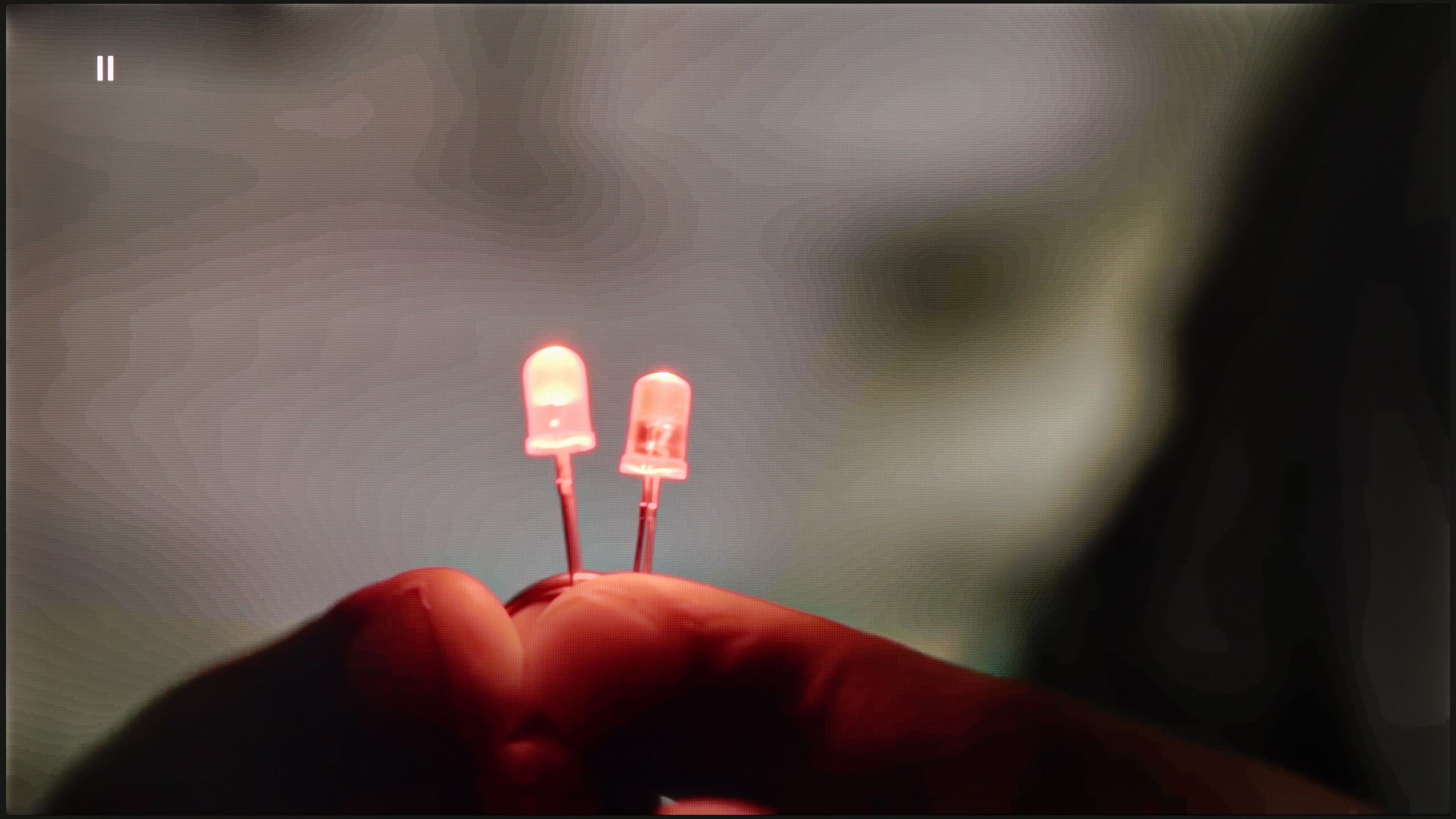
Image without overscan on the SD signal


Judging by how PML9009 Philips handled tonal transitions, the image scaling test should perform just as well. This time, we are checking the TV’s algorithms responsible for enhancing the quality of images that were recorded in lower quality. Such images can be found, for example, in various TV shows or older films. In this regard, Philips PML9009 performs quite mediocrely and drastically blurs the image. This is particularly noticeable on fine branches or the model's hair.
Let’s revisit the issue of tonal transitions, which performed remarkably well. Within the unit, we will find several levels of smoothing. Even the lowest one can effectively eliminate any jerky tonal transitions and will be suitable for the vast majority of materials. More importantly, none of the settings for this function soften the effect of film grain, which is extremely important in terms of alignment with the director's vision. However, we would like to point out that sometimes it may turn out that fine details are blurred.
TCL C6K performs quite well in terms of upscaling. Lower quality materials appear acceptable, and the absence of overscan issues means the image is displayed in full, without cropping. However, one cannot expect miracles – very low quality content won't come to life here, as the image processor has its limitations. On thin lines or details, there is characteristic tearing visible, which indicates a lack of advanced image enhancement algorithms. It is also a shame that the C6K lacks the function of smoothing tonal transitions – in older films or video materials, colour banding can be noticeable and may be distracting during longer viewing sessions.
Blur and motion smoothness
7.7/10
7.3/10

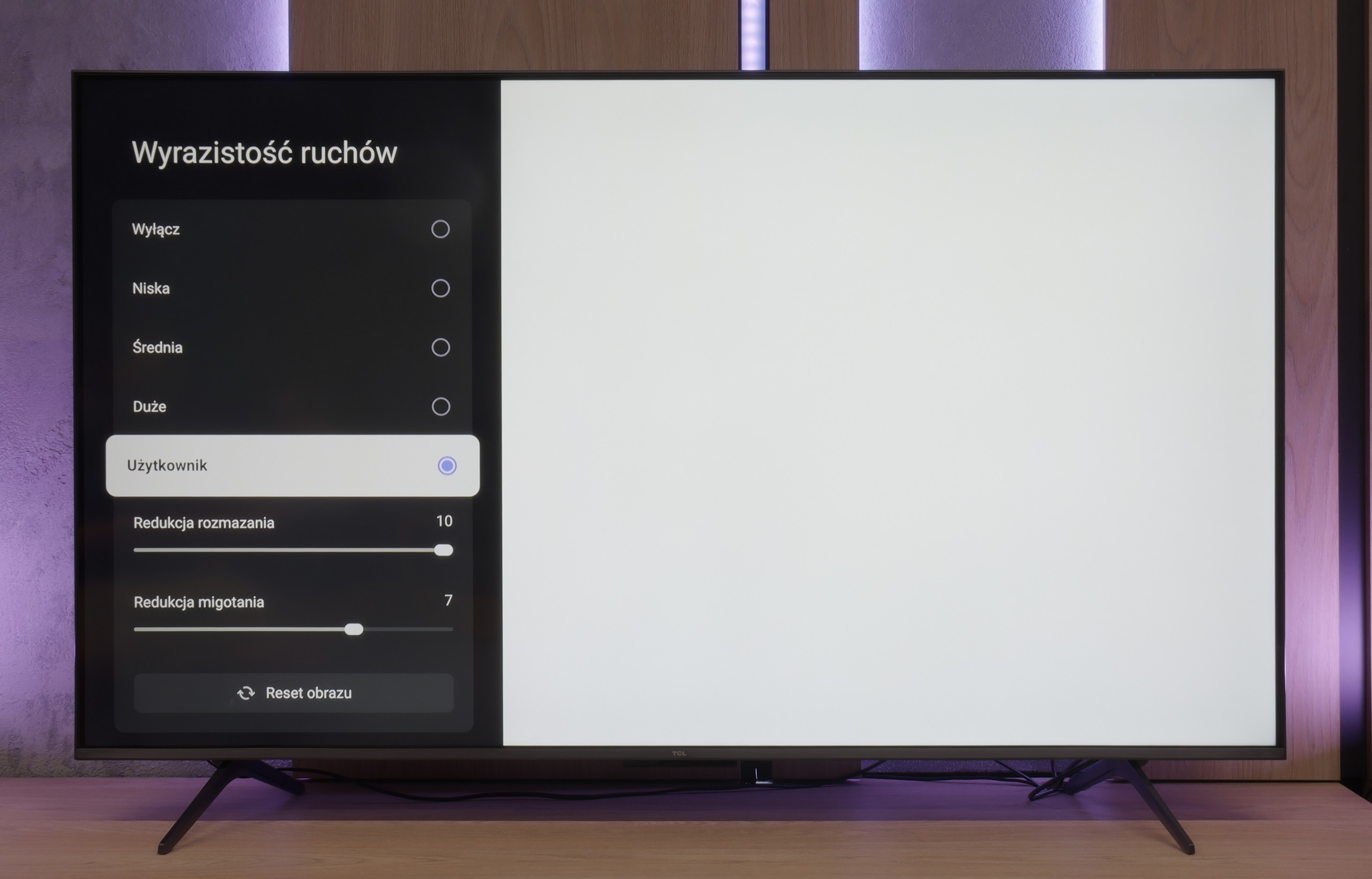
Blur (native resolution, maximum refresh rate):






Blur (BFI function enabled):



Philips PML9009 has been equipped with a panel that has a native refresh rate of 120 Hz. This is the essential minimum for watching all kinds of sports and is recommended for comfortable gaming in favourite titles on consoles or PCs. The manufacturer, for those who dislike the characteristic judder of footage recorded at 24 fps or those requiring a high degree of motion smoothness, such as when watching football matches, has prepared an effective system for improving the sharpness of moving images. In the dedicated tab, we will find a "Smoothness" slider responsible for eliminating judder and a "Motion Blur Reduction" setting that helps to increase the sharpness of dynamic elements. The function works very well and granularly, meaning each setting has a real impact on motion perception. With such a set, every user will find their sweet spot. In the picture, we present our choice, which is slight smoothing without the soap opera effect.
A matter directly related to motion is the response time of the pixels in the panel itself. The best in this regard are of course OLED panels, followed by units based on IPS and ADS screens, and lastly VA. Despite the generally good quality of the systems responsible for smoothening the image, the use of a VA panel carries consequences in the form of black smear behind fast-moving objects. Although in the tested television this should not occur frequently, it will be noticeable here and there.
TCL C6K uses a 144 Hz panel, which is a significant advantage in this price range. It's an important step forward in comparison to the previous model C655 PRO, which only offered 60 Hz in 4K. The difference is especially noticeable when watching sports or playing games – the ball, players, or fast action in the game are displayed more clearly and without losing detail. An interesting fact is the panel's ability to operate at 240 Hz, which the manufacturer doesn't mention in official materials. We will return to this topic when discussing the PC gaming mode.
TCL has also added a feature for movie watchers: "Motion Clarity," which allows users to adjust the image according to their preferences with two simple sliders. You can either keep the visible film frame or opt for a very smooth, almost theatrical effect. This way, everyone can find settings that match their taste.
Console compatibility and gaming features
9.8/10
9.8/10
- ALLM
- VRR
- VRR range48 - 144Hz48 - 240Hz
- Dolby Vision Game Mode
- Correct implementation of HGIG
- 1080p@120Hz
- 1440p@120Hz
- 4K@120Hz
- Game bar

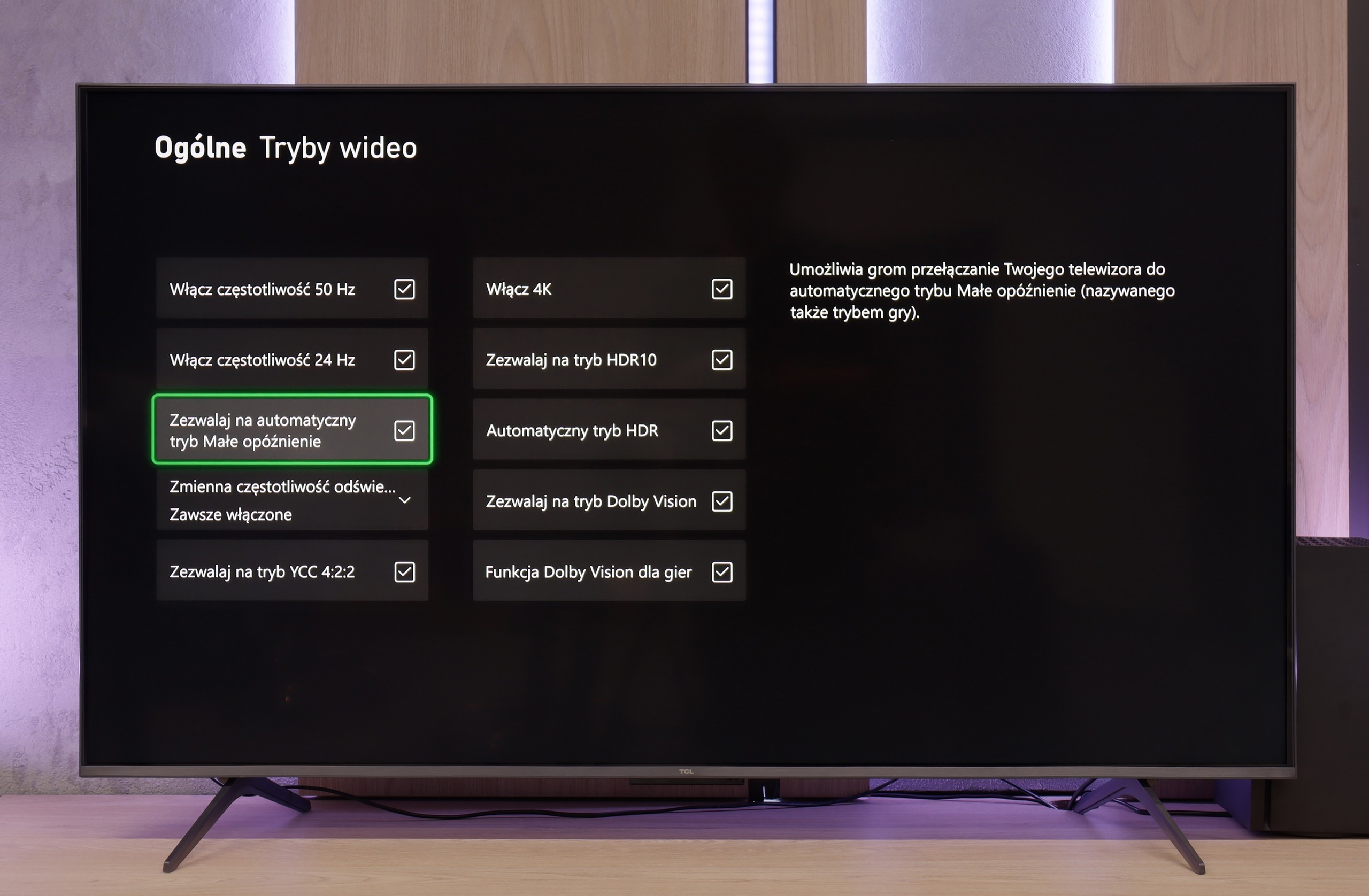

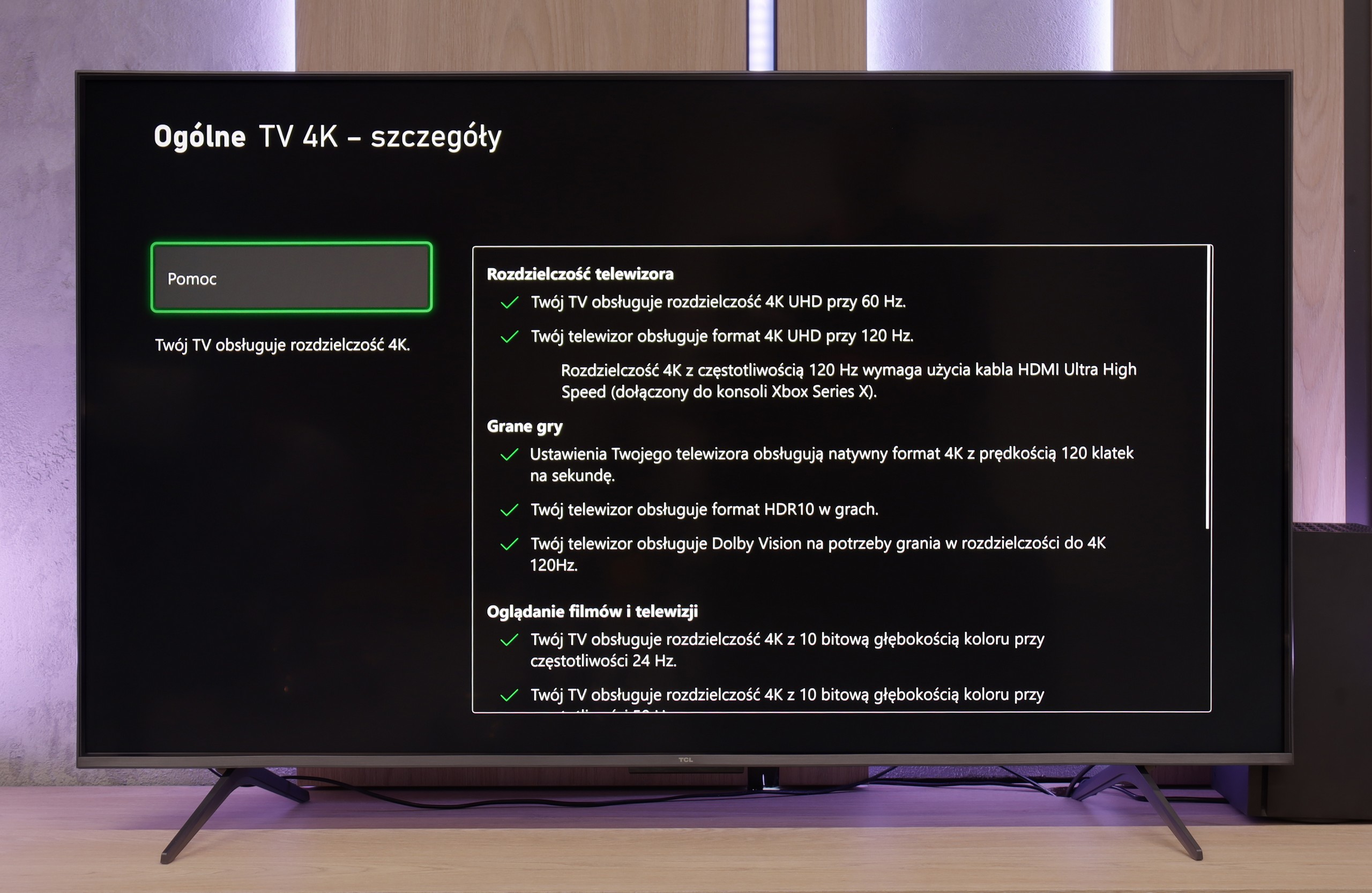

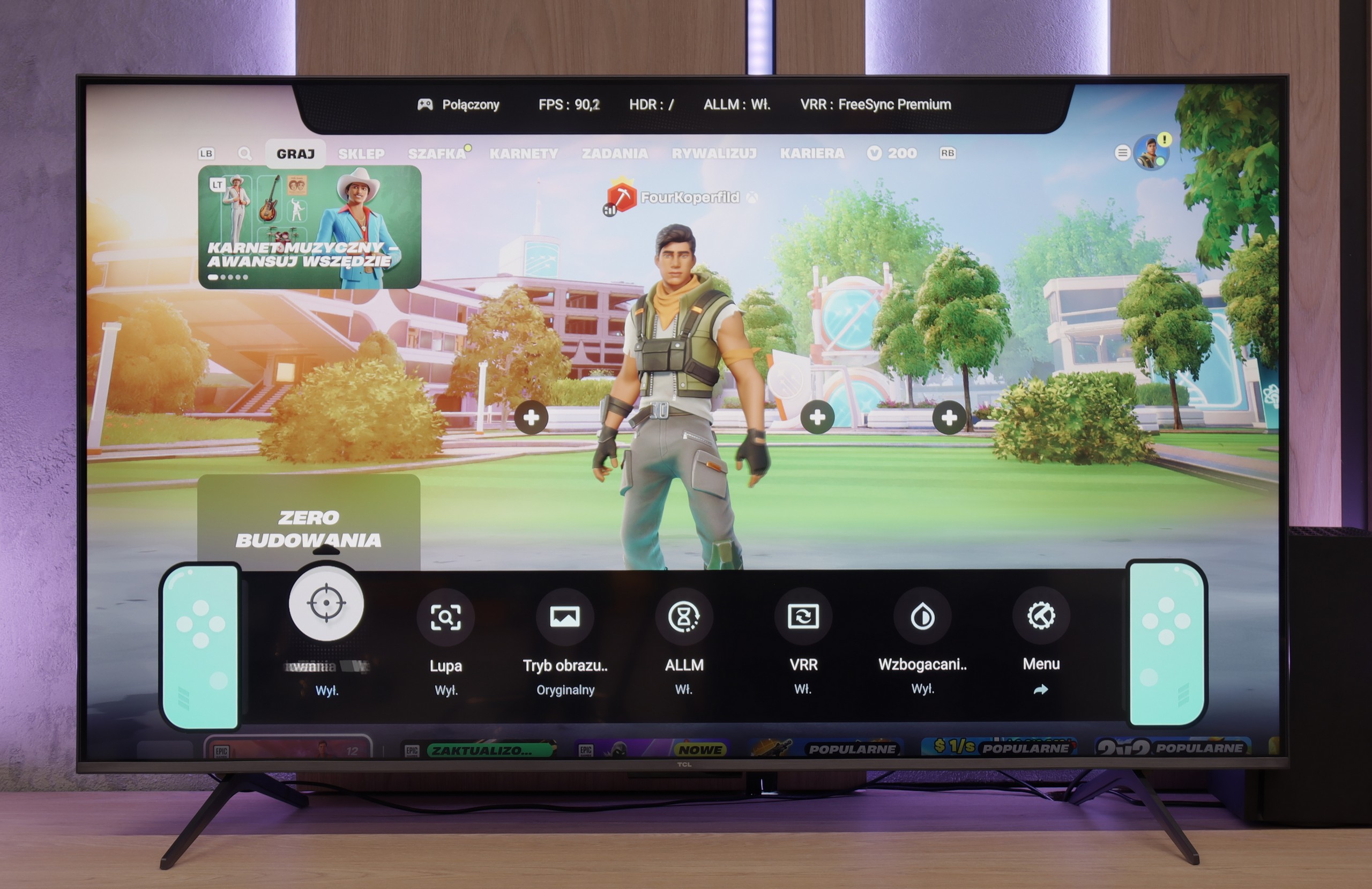


Philips PML9009, equipped with HDMI 2.1 connections with full bandwidth, supports all functions dedicated to gamers. The most basic ones, such as VRR and ALLM, are a given, but G-Sync, FreeSync, or playing in HDR Dolby Vision with low input lag are not. These features activate without any problems, and during the tests conducted, they presented no obstacles. Such preparation of the television is certainly its strong point, and it can be said that it is a unit dedicated to gamers. For more advanced users, we also mention that the PML9009 is equipped with the HGIG mode, which will be particularly felt by gamers, as there are still relatively few games that support Dolby Vision. This mode primarily allows for the adjustment of HDR effects to the capabilities of the television on a special board, to prevent dimming and burning of the image.
The television additionally implements a special menu - GameBar. This allows for editing unit settings "on the fly," meaning without having to exit the game. In it, we will also find functions such as activating a crosshair or black level correction for better visibility of opponents in shadows.
In a brief summary of this paragraph, the Philips PML9009 is a unit that will undoubtedly attract gamers' attention. Thanks to its versatility, it will allow for playing any title in the highest quality without compromises. Especially since features such as VRR, ALLM, G-Sync, FreeSync, or gameplay in HDR Dolby Vision will provide an even greater immersion in the favourite title.
The TCL C6K is a television that can confidently be called equipment designed for gamers. We have 4K at 144 Hz, VRR support, an automatic gaming mode (ALLM), and Dolby Vision Gaming. On top of that, there's a practical Game Bar, which is a panel with the most important settings handy – useful when we want to quickly change something during gameplay (e.g. screen ratio: Yes, you can!). Notably, it has a wide range of VRR, reaching up to 240 Hz. However, this option is mainly for PC gamers who drop below the native 4K resolution. In that case, the television can spread its wings and show additional smoothness, especially in fast e-sport titles. For consoles, we stick with the classic limit of 120 Hz, but the possibilities are still quite broad. The only slight drawback is some minor motion blur that can occasionally be seen in dynamic scenes. Other than that, the C6K offers everything gamers expect from a television.
Input lag
9.6/10
9.7/10
SDR
HDR
Dolby Vision
The results of input lag measurements in Philips PML9009 are impressive, regardless of the signal or resolution. All gamers will certainly appreciate the efforts of the manufacturer, which have led to a game running at 4K120Hz with HDR having only 8 ms of delay, which is practically undetectable even in online games. One should also not forget about the proper implementation of game mode with Dolby Vision, which can be praised for a similar response time of 16 ms.
In terms of input lag, the TCL C6K performs excellently. With 120 Hz content, the delay is around 10 ms, and at times even less. This is at a level where the response is practically instantaneous, and it’s hard to find any complaints. For 60 Hz materials, the result is around 18 ms – still a very good result, more than adequate for comfortable gaming.
Compatibility with PC
8.6/10
8.6/10

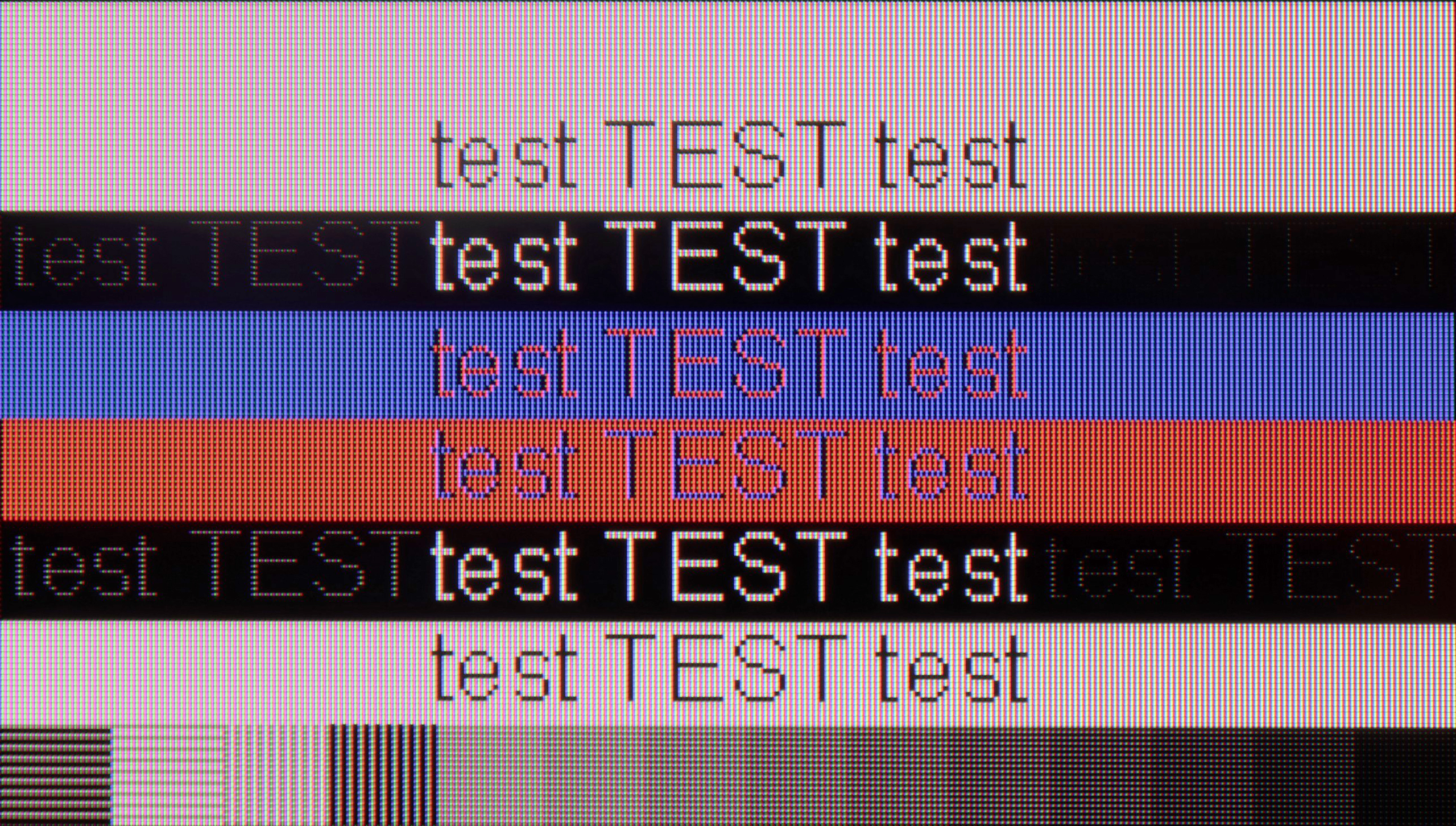
Just like in games, the tested Philips PML9009 performs excellently in everyday use as well. Measured latencies of 8 ms allow for virtually instantaneous response between the mouse, screen, and eye. The correct implementation of chroma 4:4:4 enables working with text without any problems thanks to sharp fonts. The subpixel arrangement of the matrix is BGR, although this does not cause any discomfort when working on the Windows system. It may be different with other systems that may not be able to correctly convert text.
After connecting the TCL C6K to the computer, it performs excellently. At native resolution, we have 4K at 144 Hz, and if we lower the resolution, we can even achieve 240 Hz. Additionally, the TV works well with Nvidia and AMD cards – it supports both G-Sync and FreeSync. It’s also hard to fault for office work. Fonts are sharp and readable thanks to 4:4:4 chroma support, and any minor imperfections are so negligible that they're simply not noticeable in regular use.
Viewing angles
2.6/10
3/10
A commonly known drawback of VA panels that do not have an angle coating is their poor viewing angles. This time is no different. Even after a small shift off-axis, the image becomes washed out, and the colours undergo significant degradation.
In the TCL C6K, the viewing angles are typical for VA panels. Sitting directly in front, the picture looks very good, but any movement to the side results in a noticeable drop in colour saturation and brightness. The difference is particularly evident in colourful scenes – the hues become washed out, and the contrast loses its depth. Compared to IPS panels, this is clearly a weaker result, although the better black levels and higher native contrast remain a compensating factor – "you win some, you lose some".
TV efficiency during daytime
6.1/10
6.4/10

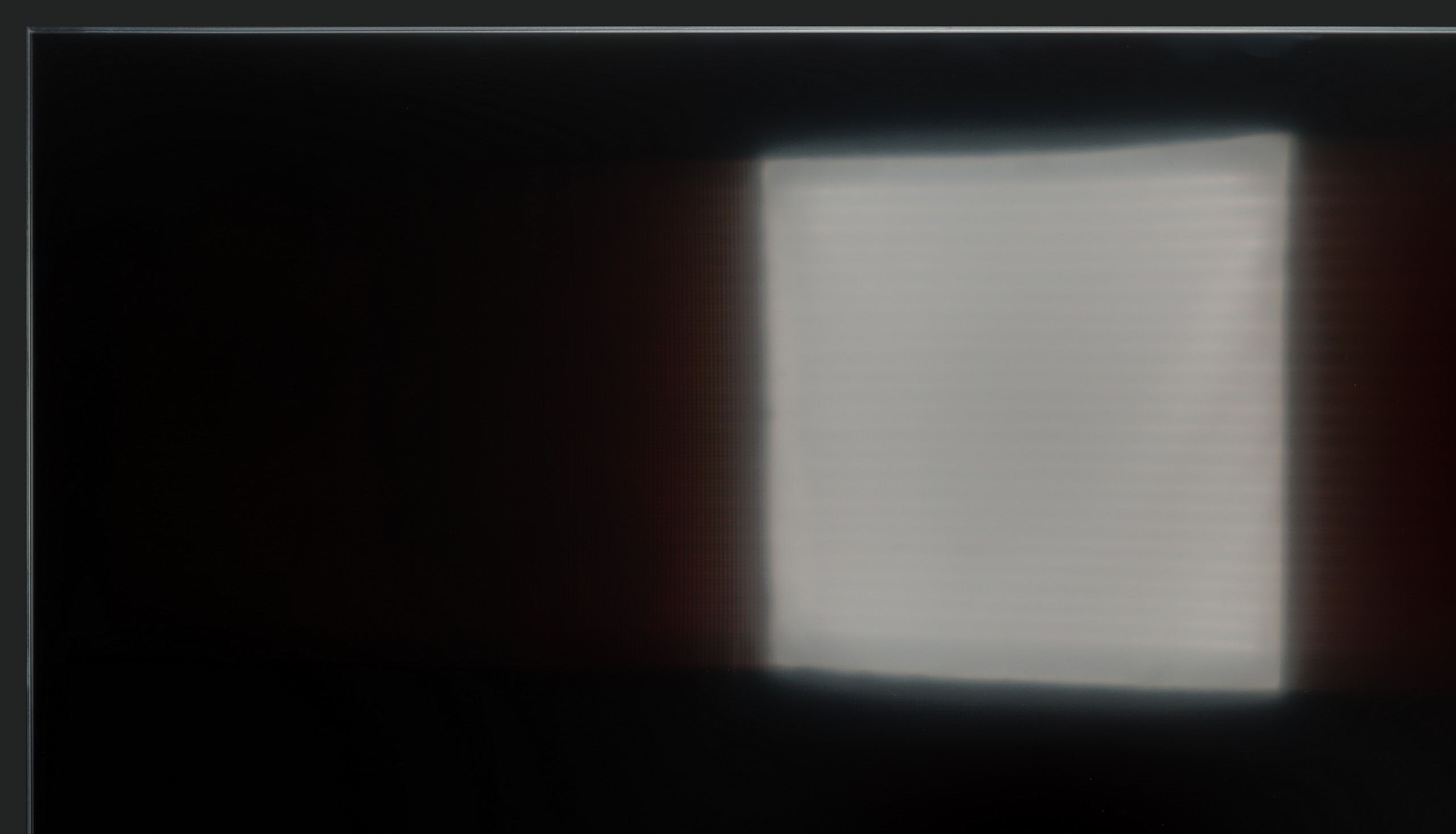


Matrix brightness
Average luminance SDR
TCL C6K: 532 cd/m2
Philips PML9009 / 9019 / 9059: 564 cd/m2
As far as the brightness of the TV itself in SDR content is good (let's face it, we watch movies in the evening or in the dark), the reflection suppression is at a rather average level. This is due to the satin finish of the panel, which is quite susceptible to all light sources and neither absorbs nor disperses them. However, it's worth noting that due to the quite high brightness in SDR content, the TV will overall perform fairly well in bright rooms, and certainly better than a large portion of OLED TVs.
TCL C6K performs quite well in bright lighting conditions. The panel offers decent brightness – achieving around 550 nits in SDR content, which allows for comfortable viewing in a moderately lit lounge, even on days with strong light coming through the windows. This means that daytime viewing does not require complete darkening of the room. It's also worth noting that the screen coating does quite a good job of reducing reflections, so the TV doesn't turn into a "mirror" even with bright lighting. However, this is not on the level of top models with more advanced anti-reflective coatings – in very challenging conditions, such as large windows, reflections will be noticeable.
Details about the matrix
Subpixel Structure:

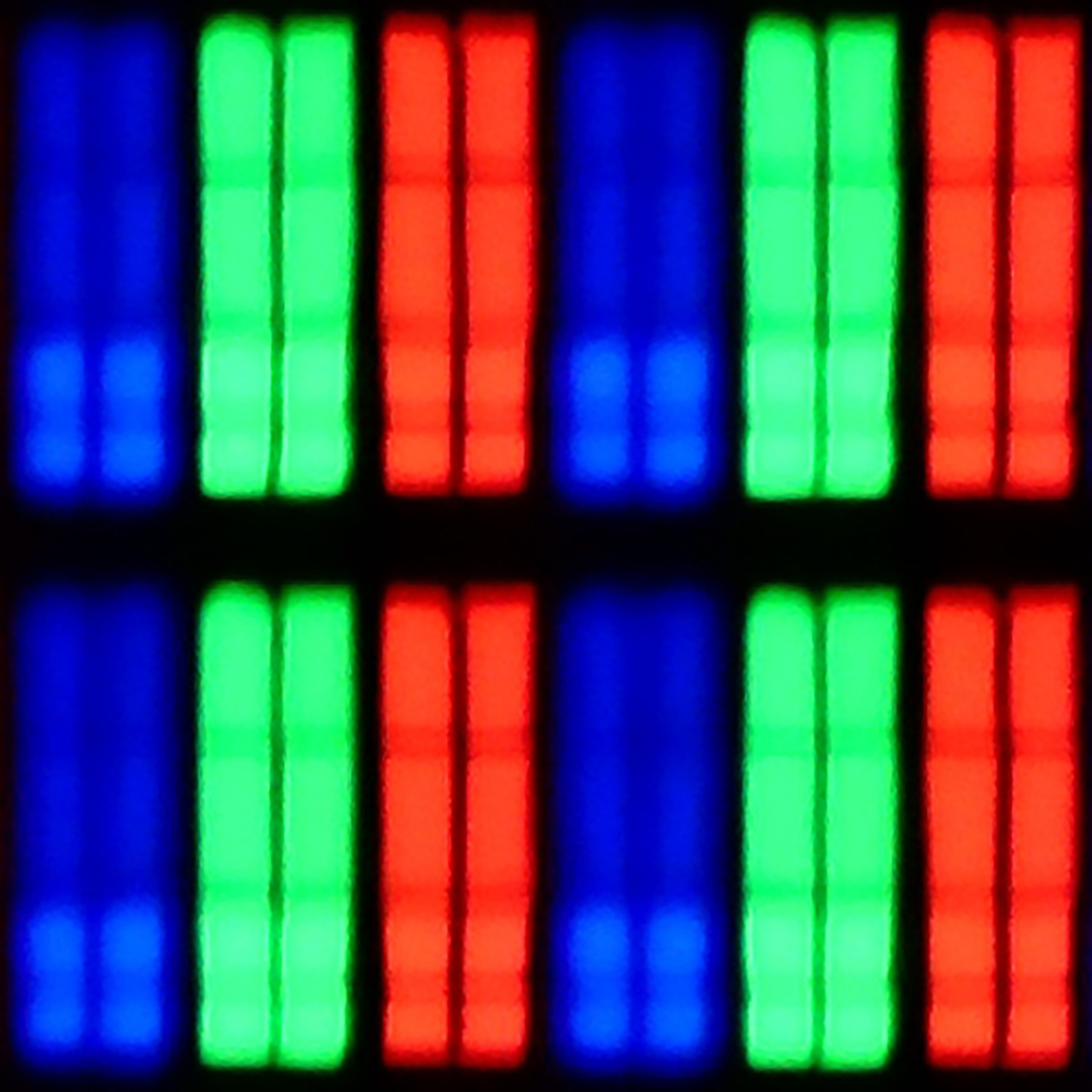
Panel uniformity:


Philips PML9009 / 9019 / 9059
TCL C6K
TV features
6/10
7/10
- HDMI inputs0 x HDMI 2.0, 4 x HDMI 2.1 48Gbps2 x HDMI 2.0, 2 x HDMI 2.1 48Gbps
- OutputsToslink (Optical audio), eARC (HDMI), ARC (HDMI), Mini-Jack (Headphones)Toslink (Optical audio), eARC (HDMI), ARC (HDMI)
- Network InterfacesWi-Fi 2.4GHz, Wi-Fi 5GHz, Ethernet (LAN) 100MbpsWi-Fi 2.4GHz, Wi-Fi 5GHz, Ethernet (LAN) 100Mbps
- TV receptionDVB-T, DVB-T2, DVB-S, DVB-S2, DVB-CDVB-T, DVB-T2, DVB-S, DVB-S2, DVB-C
Classic features:
- Recording to USB (terrestrial TV)
- Recording programming
- Picture in Picture (PiP)
- RF remote control (no need to aim at the screen)
- Backlit remote control
- Teletext
- Audio only mode
- Possibility to connect Bluetooth headphones to the TV
- Possibility to simultaneously use Bluetooth headphones and the TV speaker
Smart features:
- AirPlay
- Screen mirroring (Windows Miracast)
- Wyszukiwanie głosowe
- Voice search in native language
- Ability to connect a keyboard and mouse



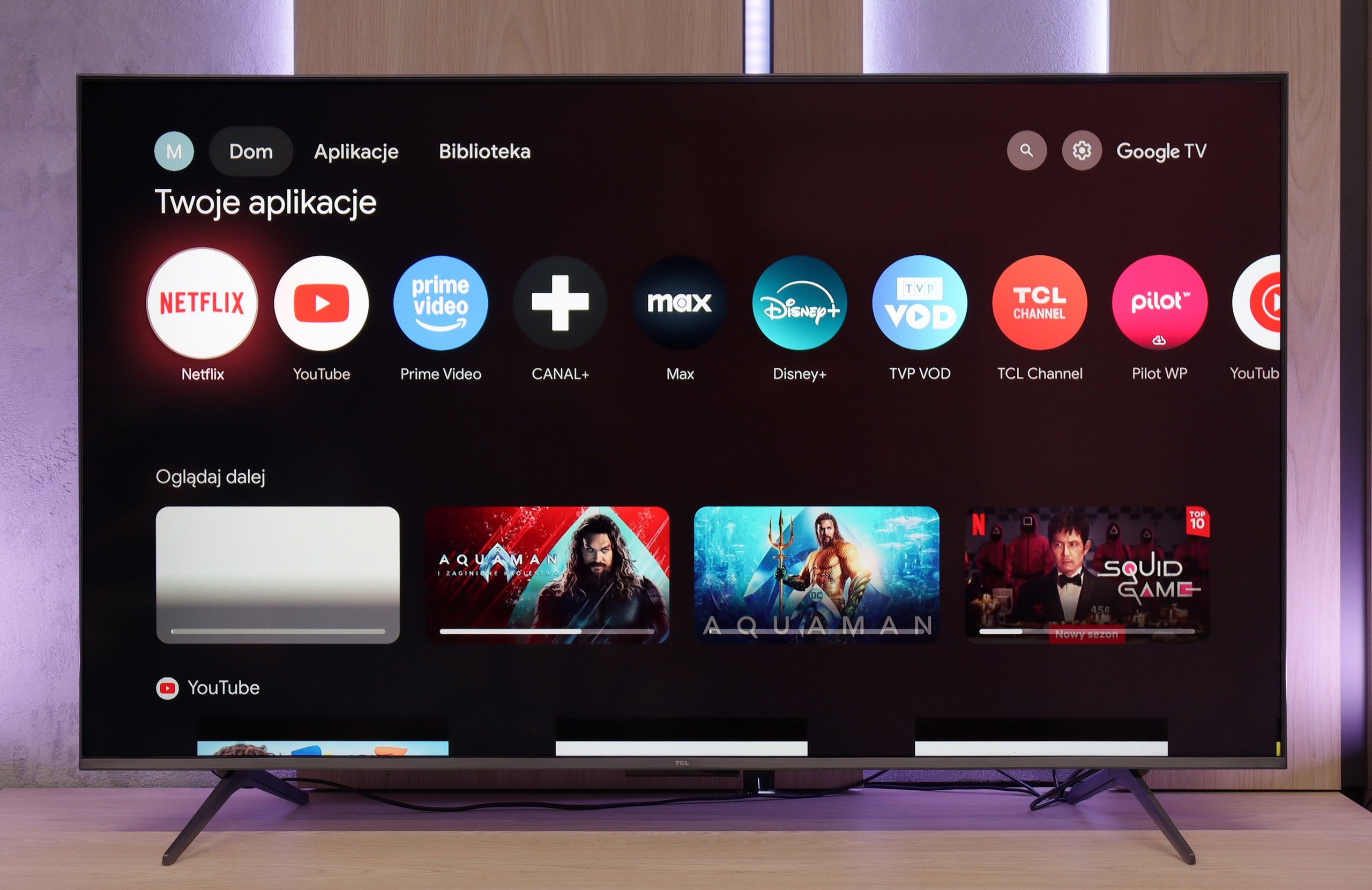
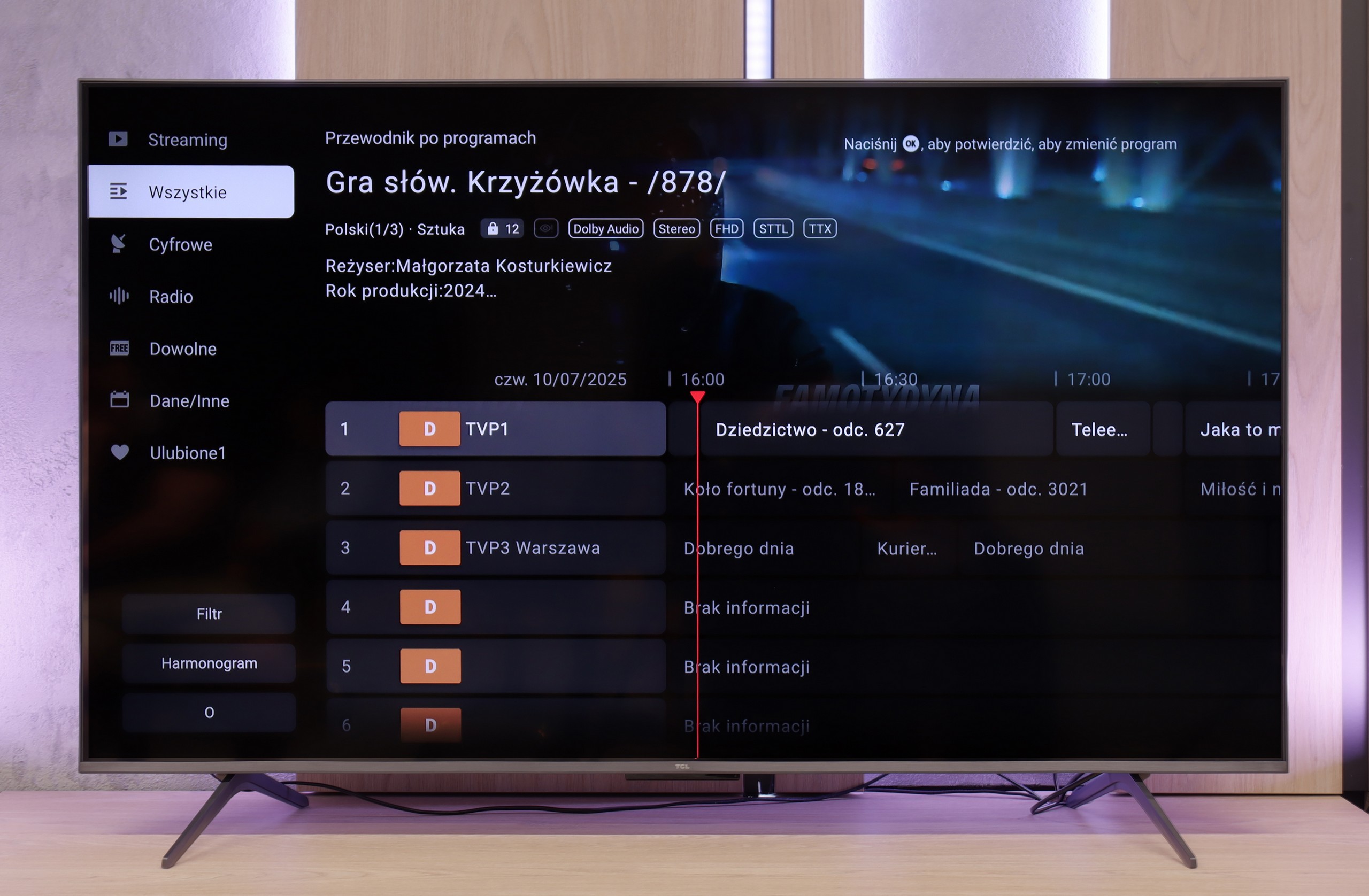
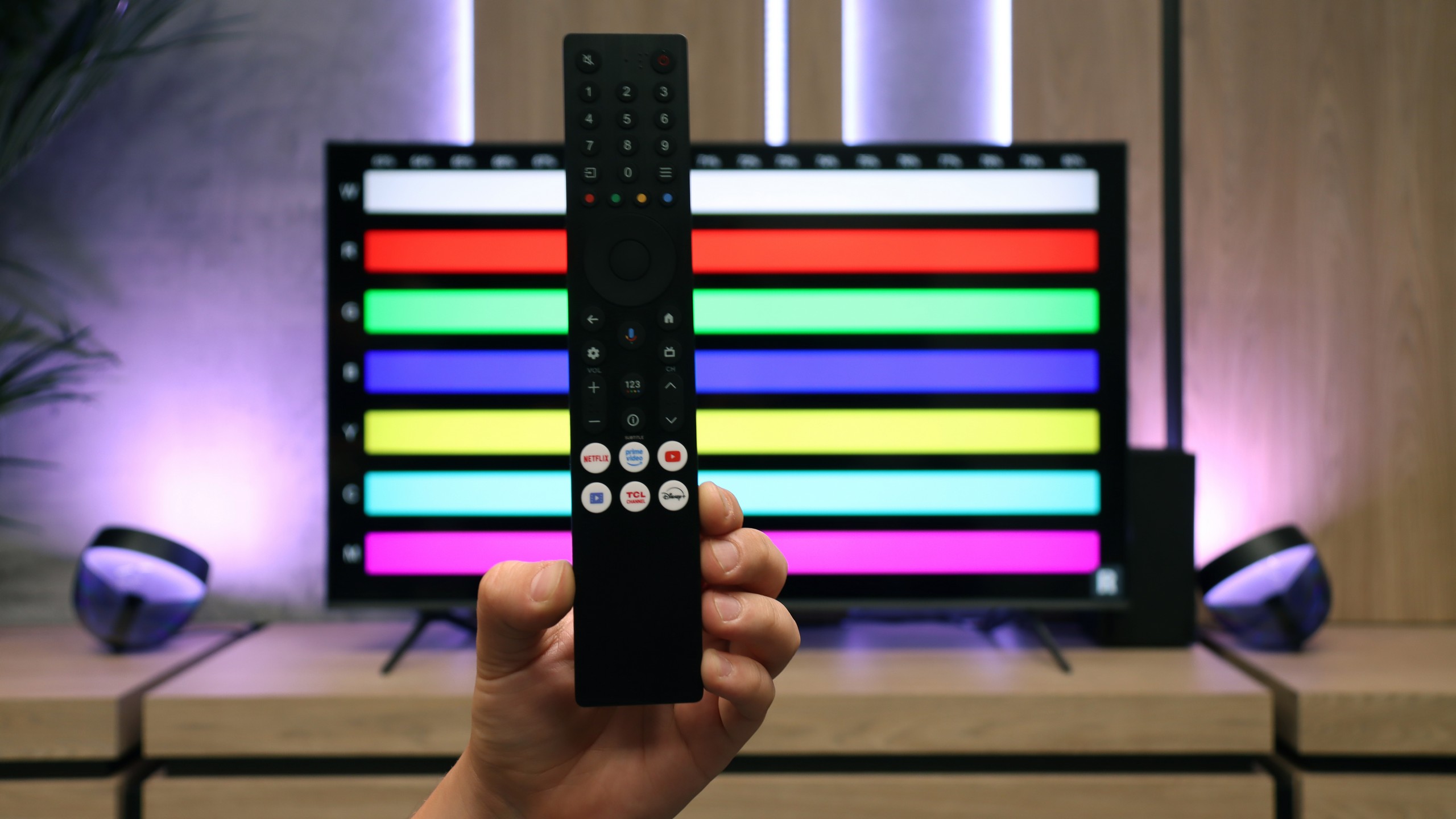
Before we dive into the software that controls the television, it's impossible not to mention the biggest standout feature of the manufacturer's TVs. We're talking, of course, about the multicoloured Ambilight backlighting, which is placed on the back of the device and displays colours that adapt to what's happening on the screen, often allowing for an even greater immersion experience. The operating system responsible for the TV's functioning is Philips' proprietary system, charmingly named TitanOs. It is definitely more closed off and limited in terms of application resources compared to other TVs from the manufacturer that use GoogleTV. Besides the lack of essential applications, its closed nature also reveals itself in another way. We won't be able to perform such basic tasks as programming recordings or recording to USB. People using Apple devices may also feel disappointed by the lack of the AirPlay function, which allows for easy screen streaming. Fortunately, there is the option to connect a keyboard and mouse for more efficient navigation through the TV's menu. It's also worth mentioning that while the remote pairs via BT, it only works for voice selection in English. The rest operates via IR...
In summary: TitanOs has quite a few "buts," especially for those of us who are aware users needing and using multiple streaming platforms. It's more of an option for those limiting themselves to the so-called holy trinity: Netflix, YouTube, and CDA.
Multimedia Features: Google TV
The standout feature of the TCL C6K is undoubtedly the Google TV system. It gives the television its character and gives it an edge over many competitors. We have a full suite of services – from support for popular streaming apps, through screen mirroring support, to AirPlay, so iPhone users will feel right at home. Additionally, there's Google Assistant (now in the Gemini AI version), which not only answers questions but also efficiently carries out simple commands like changing channels or searching for content on VOD services. The system itself operates quite responsively, although it’s hard not to mention a certain drawback – the clumsy translations in the Polish menu can elicit a smile but sometimes require a moment of thought to decipher what’s really meant.
Classic Features
When it comes to classic television features, the TCL C6K is rather average. We won’t find USB recording or PiP mode, which may be disappointing for some. However, the manufacturer hasn’t forgotten the basics – teletext television and a clear EPG are available, which still hold significance for some users. In everyday use, support for external audio devices via Bluetooth comes in handy – a straightforward way to connect a speaker or headphones, which could be a practical solution for seniors. Beyond that, it’s hard to spot elements that would distinguish the C6K from its competitors – it’s simply a solid, but standard package of basic features.
Playing files from USB
8.2/10
8.9/10
Supported photo formats:
Maximum photo resolution:

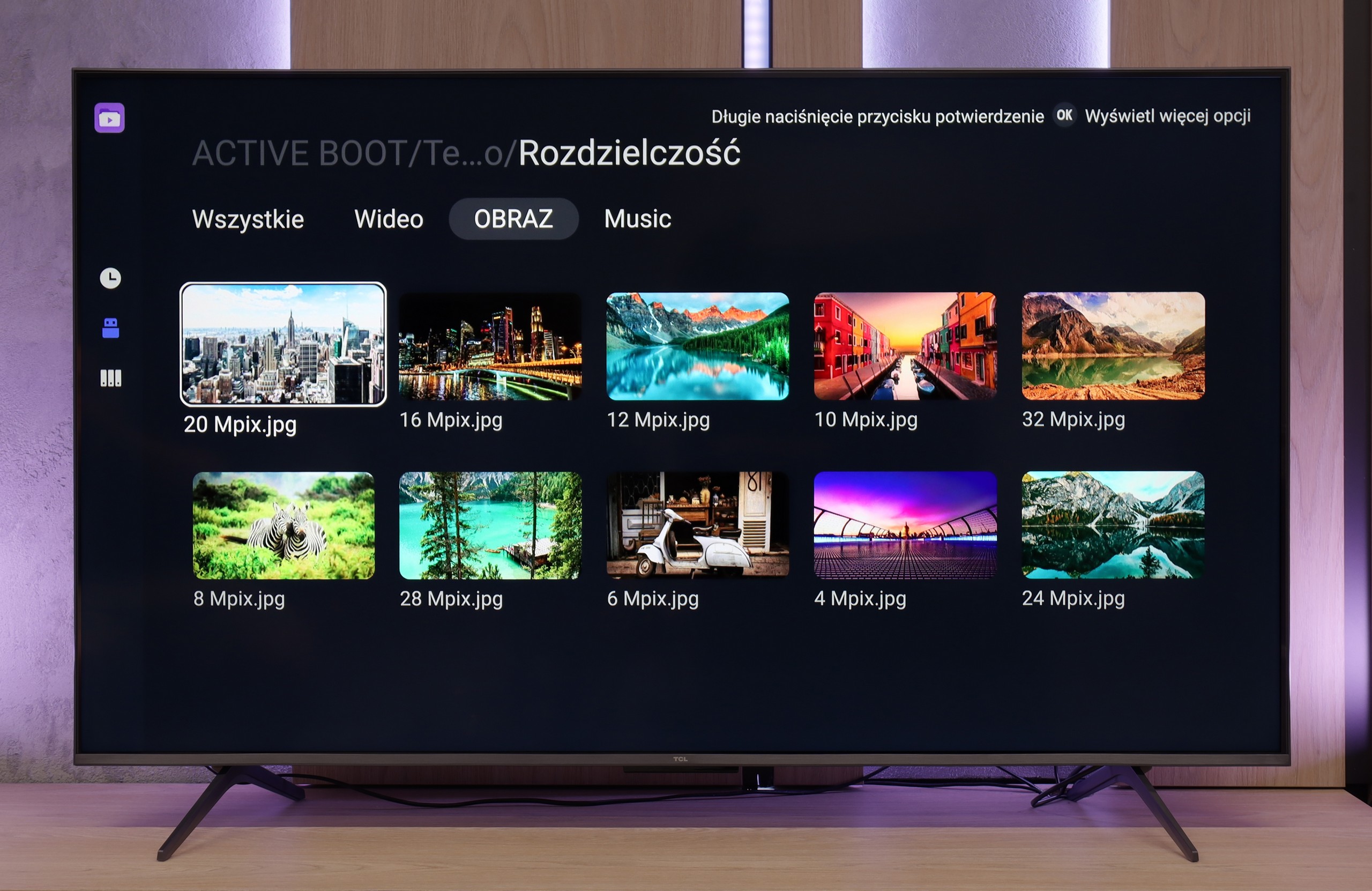
The default media player built into Philips PML9009 offers quite a wide range of capabilities but also has its limitations. It plays virtually all video formats except for .asf, which is not commonly encountered. However, there are issues with the lack of support for the H.265 HEVC codec at high bitrates and .sub files, which are quite popular. When it comes to photos, the player performs adequately, but it lacks support for some popular resolutions and formats, such as HEIC, which is used on Apple devices. The player handles audio the best, where it has no complaints. Unfortunately, due to system limitations, there is no possibility of function expansion, meaning we are left with what the manufacturer has prepared.
The built-in media player in the TCL C6K performs really well – practically all popular file formats work without major issues. There are minor exceptions, particularly with less common codecs or unusual video file configurations, but in everyday use, this rarely becomes noticeable. The biggest plus, however, is that the television runs on Google TV, which offers complete freedom in choosing additional software. If someone encounters a file that the standard player can't handle, all they need to do is install an alternative – like VLC – and the problem disappears.
Apps
6.2/10
9.6/10














































Sound
6.7/10
6.5/10
- Subjective sound quality:6.7/106.5/10
- Dolby Digital Plus 7.1:
- Dolby True HD 7.1:
- Dolby Atmos in Dolby Digital Plus (JOC):
- Dolby Atmos in Dolby True HD:
- DTS:X in DTS-HD MA:
- DTS-HD Master Audio:
To begin with, it is worth noting that sound quality is a subjective matter. The built-in audio system in Philips PML9009 stands out with clear high tones, but the bass is quite flat and significantly worse than in competing models in the same price range.
In terms of audio, the TCL C6K performs quite well. The manufacturer has been boasting about its collaboration with the Onkyo brand for several years, and it indeed reflects on the sound quality. The sound is pleasant, with clear mid-tones and fairly crisp highs, and overall, it gives the impression of being well-balanced. Of course, it won't replace a proper soundbar, especially regarding bass depth, but for built-in speakers in a TV from this price segment – it’s really quite good.


